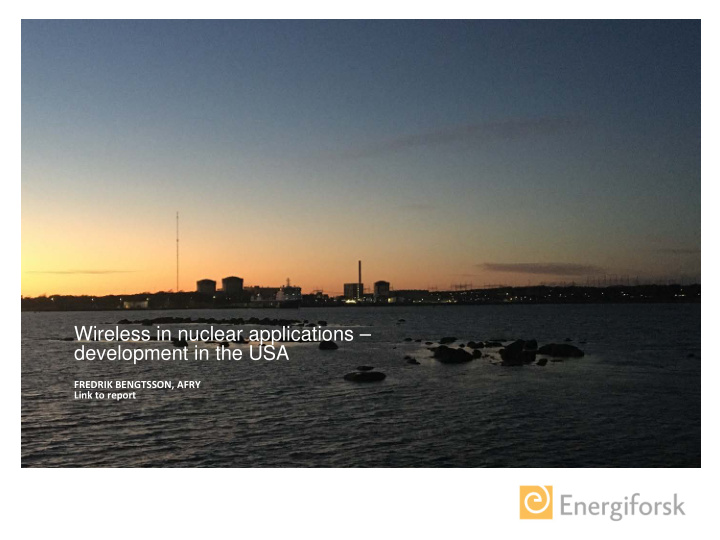



Wireless in nuclear applications – development in the USA FREDRIK BENGTSSON, AFRY Link to report
Scope • Wireless technology has traditionally not been used in nuclear applications, mainly due to restrictions in safety and security. One of the major concerns is the impact from electromagnetic compatibility (EMC) and the vulnerability to wireless transmission for safety functions. The development of wireless applications has however been very strong during the last years, and the technology is widely used in other industries. Nuclear Power Plants in the US have come quite far regarding implementing wireless solutions in different applications. The objective for this study has been to increase knowledge on • opportunities and challenges regarding wireless installations by studying U.S. nuclear applications • Following companies/organizations were visited: EPRI, Duke Energy, AMS, Dominion and Exelon
Results • Common for all was that the nuclear power plants need to reduce cost in order to be competitive at the market. • A common denominator for all utilities is the digitalization and the use of wireless equipment. Prerequisite for digitalization is the infrastructure. There is no single solution that suites all NPPs, • instead this need to be analysed case by case. • There are challenges of addressing EMC and the use of exclusion zones is one way to handle this Diagnostic & Monitoring Center and is widely used in USA - But it can also limit wireless installations. • The establishment of a Monitoring and Diagnostic centre, where all available plant/fleet data are collected and analysed, could improve the performance and plant efficiency. NPP NPP NPP NPP
Results Prerequisite for digitalization is the Power ”Big Data” - Monitoring & Diagnostic Center infrastructure the so-called enabler. Company/Site There are many different solutions for Public Power Plant an infrastructure that supports Cloud Digitalization. IT Administrative Process Control and network or process safety Mobile WIFI Tech IT network system worker Private Cloud Camera Sensors The figure illustrates different DAS approaches and that data is collected Gateway Antennas 13 U 3G/4G at a Monitoring & Diagnostics Center. 9 U 5 U 1 U • Wi-Fi used for administrative 2 U Camera work like Electronic Work 1 U WIFI Sensors 1 U Packages and also for connecting Distribution Remote cameras, sensors etc. Radio Base Unit Station Carrier Station 900 MHz, Zigbee, Sensors Connection • DAS system for traditionally Z-Wave etc. communication devices but also for connecting different kind of sensors and applications.
Summary and Conclusion Common for all visited company was that the • nuclear power plants have to reduce cost in order to be competitive in the market. The common denominator for all utilities that were visited was the digitalization. • More measurements and data will enable power plants to go from a time-based maintenance to maintenance based on condition instead. • Electronic Workpackage was another goal for all/many of the powerplants. • The establishment of a Monitoring and Diagnostic centre, where all available plant/fleet data is collected and analysed, could improve the performance and plant efficiency. • Prerequisite for digitalization is the infrastructure the so-called enabler. There is not one kind of solution that suite all NPP’s instead this need to be analysed case by case. • Exclusion zones for wireless equipment are used in USA to solve the issue with EMC.
Recommend
More recommend